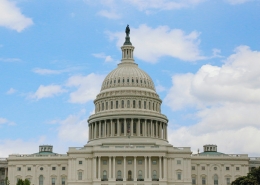Over four years after the last efforts to enact legal authorization for self-driving cars went up in smoke, a House subcommittee this week held a hearing to explore new legislation.
On Wednesday, July 28, the Subcommittee on Innovation, Data, and Commerce under the House Energy and Commerce Committee met to discuss a self-driving vehicle legislative framework, with the goal of enhancing safety, improving lives and mobility, and “beating China.” Chaired by Representative Gus Bilirakis (R-FL), the subcommittee explored two draft bills: the Safely Ensuring Lives Future Deployment and Research In Vehicle Evolution (SELF DRIVE) Act sponsored by Representative Bob Latta (R-OH) and an amendment to title 49 of U.S. Code to provide for updated and new motor vehicle safety standards and regulations for automated vehicles, sponsored by Representative Debbie Dingell (D-MI).
Four witnesses testified at the hearing (click on their name to read their prepared testimony):
- Mark Riccobono, President, National Federation of the Blind
- John Bozzella, President and CEO, Alliance for Automotive Innovation (AAI)
- Gary Shapiro, President and CEO, Consumer Technology Association (CTA)
- Philip Koopman, Ph.D, Associate Professor, Carnegie Mellon University
The witness testimony focused on six key elements of the draft legislation and automated vehicle (AV) development: safety, accessibility, federal preemption of state and local law, workforce impacts, global competitiveness, and cybersecurity.
Safety: The safety of road users is critical with the development of AVs and self-driving. Accidents involving self-driving technology have made the news in recent months: the Washington Post reported that data as of June 2023 indicates that 17 fatal incidents can be definitively linked to the technology. While the technology is not yet infallible, neither are human drivers. It is possible that the rate of fatalities per automated vehicle mile is less than the rate of fatalities per human-driven vehicle mile, but this author has yet to see empirical data that shows this is the case.
Dr. Koopman indicated that it is too soon to tell in terms of fatalities. The witnesses expressed confidence in the safety of the technology and a need for incremental testing and implementation in niche areas of the market where safety can be guaranteed. Riccobono rightly pointed out that self-driving technology cannot benefit the visually impaired who cannot legally drive until it is advanced enough to eliminate sight requirements and the need to intervene. Dr. Koopman also noted that a safety-focused regulatory framework was proposed in a notice of proposed rulemaking from NHTSA in December of 2020, and it just needs to be implemented.
Shapiro spoke adamantly about the need to expand NHTSA exemptions to Federal Motor Vehicle Safety Standards (FMVSS), which would allow vehicles to be sold to and tested by the American public in large number. According to Shapiro’s written testimony, exemptions are currently limited to 2500 units and are administered on a temporary basis, typically expiring after two to three years. However, Tesla is currently beta testing its full self-driving mode in vehicles across the country without an exemption, so an expansion of exemptions would essentially be a formalization of this exemption. (Ed. Note: Tesla operates under the “easier to ask forgiveness than to ask permission” approach.)
An additional consideration attached to safety is forced arbitration agreements, which currently make it more difficult for those negatively impacted in self-driving failures to hold companies accountable for damages. The draft legislation bans these arbitration agreements, a provision the witnesses spoke of favorably.
Accessibility: One of the largest potential benefits of AVs is increased accessibility for those with disabilities and decreased mobility, including the elderly. The National Federation of the Blind has long advocated for the advancement of AVs as they would increase access and eliminate bias experienced by those with disabilities from rideshare drivers.
Federal Preemption of State and Local Law: Another key provision of the draft legislation is the explicit ability for the federal government to preempt state and local law about AVs. (This issue is what blew up the AV bill in the Senate in 2018.) While Dr. Koopman expressed minimal concern (when asked about New York City, he pointed out that it is the only place in the country were AV testing is required to follow the industry safety standard J3018—Guidelines for Safe On-Road Testing of Prototype Automated Driving Systems—and federal preemption could potentially nullify this requirement if the federal standards are less strict), the other three witnesses expressed support for this provision. Bozzella urged the subcommittee members to respect the historical dichotomy of vehicle regulation: states are responsible for licensing, registration, and traffic enforcement, while the federal government is responsible for vehicle safety and engineering standards.
Workforce Impacts: As with any emerging technology, automated vehicles will impact the current workforce, most critically the 4 million Americans that are currently employed as drivers. Witnesses predicted that there would also be job creation related to AVs, likely higher skilled. When prompted, the witnesses agreed that the workforce impacts should be considered in this legislation.
Global Competitiveness: The biggest concern during this hearing (no, it was not the safety of road users), most notability with Republican members of the subcommittee, was that the United States was falling behind globally in the AV market, especially against China. The witnesses expressed concerns that U.S. regulatory frameworks currently hinder AV development in the United States. According to full committee chairman Cathy McMorris Rogers (R-WA), seven Chinese companies are currently testing AV technology in the United States, but that American companies are not allowed to test the technology in China. Shapiro noted that development of a new automotive technology in the United States usually takes a 10-year investment from a company, one that many are not willing to make currently because of a lack of a regulatory framework that creates future uncertainty of testing and development conditions. Witnesses and subcommittee members pointed to the loss of global leadership because of our initial lack of federal leadership on semiconductor and electric vehicle development and predict a similar situation with automated vehicles if more federal leadership does not come soon.
Cybersecurity: As with any new, more-integrated technology, there are cybersecurity risks, as great amounts of data are created and stored to develop and implement the technology. All vehicles, automated or not, should adhere to strict cybersecurity standards to prevent data theft and malicious activity.













